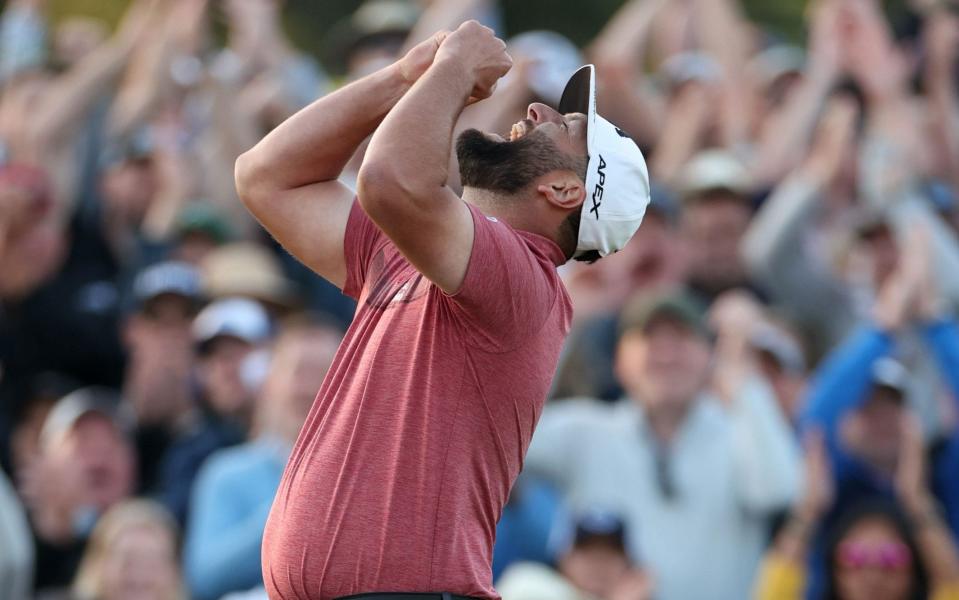Step aside Rory McIlroy, Jon Rahm must carry Europe’s Ryder Cup torch

The urge to anoint Jon Rahm as the heir to Seve Ballesteros was so acute that host broadcasters CBS, offering a typically syrupy Masters summation, turned their hands to numerology. Noticing that Adam Hayes, Rahm’s caddie, was wearing No 49, they could not help but see celestial symmetry in how this could also be read as “4/9, Seve’s birthday”. This might most kindly be described as straining for profundity – not least because the date would be written in Spain as 9/4.
In many ways, the parallels with Ballesteros feel forced. Rahm, while wedded to his Basque roots, is a naturalised American with the twang to match, having left Spain’s to take up a golf scholarship at the University of Arizona when he was 18. The backdrop to his predecessor’s Augusta story was rather more exotic. When the great Seve, fresh from the homestead in Pedrena, won his first Masters in 1980, he still spoke only halting English, and was rapidly tiring of his hosts’ inability to pronounce his name. “Why do they keep calling me Steve?” he said.
What Ballesteros has bequeathed to Rahm, though, is a consuming passion for the Ryder Cup. Just as the great Seve derived his deepest satisfaction from crushing his US opponents, Rahm called the experience of beating Tiger Woods in singles in Paris five years ago the “best feeling of my life”. In the wake of his emphatic four-stroke victory to claim the Green Jacket, Rahm has a pivotal role to perform at the contest in Rome this autumn. Quite simply, Luke Donald, the European captain, is duty-bound to make him his on-course leader.
The identity of Europe’s Ryder Cup talisman has been fraught with uncertainty since Seve’s pomp. Ballesteros was such a galvanising force that Mark James once said: “He could have played with my mum, who doesn’t even play, and it wouldn’t have surprised me if they had got half a point.” Despite a formidable European record in winning four of the past six match-ups, there is no natural substitute for the Seve effect.

In 2014, you could have made a plausible case for Rory McIlroy’s influence, with Paul McGinley demanding that he play like a world No 1 on the final day at Gleneagles, a call he heeded by trouncing Rickie Fowler 5&4. But questions have arisen over his temperament away from home. At Hazeltine in 2016, he was so wired that he celebrated an extraordinary birdie putt against Patrick Reed by running around the green screaming, but he still lost the match. And in Wisconsin in 2021, he was so ineffectual, with three defeats out of four, that he dissolved in tears in a TV interview.
It was a lachrymose Ryder Cup at Whistling Straits, with Lee Westwood also crying on air. The one player who exhibited no such reaction was Rahm. Far from lapsing into sentiment, the Spaniard is understood to have been furious, despairing at the strategic errors that had contributed to a record 19-9 loss under Padraig Harrington. Rahm, in contrast to his team-mates, had punched his weight. On all three occasions of being partnered with Sergio Garcia, they had won. By the time he succumbed to Scottie Scheffler on the Sunday, all hope was lost.
Rahm is hell-bent on purging those frustrations this year. He combines his ox-like physique with a bullish temperament, which finds its clearest expression in the gladiatorial nature of Ryder Cup combat. Even at 28, he is so steeped in the event’s folklore that he has acquainted himself with Ballesteros’ famous shot at PGA National in 1983 – when his predecessor smashed a three-wood from a fairway bunker to rescue a half against Fuzzy Zoeller – while regretting the fact that that no footage had been kept. He has also spoken of his admiration for Jack Nicklaus conceding a putt to Tony Jacklin in 1969 to halve the match, saying: “I hope I would have done it, too.”
His distinction as a student of golf history was self-evident as the magnitude of his Masters achievement dawned. When informed that he was the first European player to win both the Green Jacket and the US Open, Rahm replied: “If there’s anything better than accomplishing something like this, it’s making history. To be the first to do this, it’s a very humbling feeling. Thank you for telling me, because I don’t know how I would have found out.”
The way in which he closed out his second major title offered a vivid illustration of his mental strength. While Brooks Koepka floundered alongside him, Rahm was poise personified, right down his Seve-esque par at the last, where he somehow escaped with a four despite clattering his tee-shot into the trees. It was a display far removed from that of McIlroy, who had allowed the pressure of trying to complete the career Grand Slam overwhelm him to the extent that he missed the cut. Rahm, there can be no doubt, is the worthiest candidate to carry Ballesteros’ torch. At the Ryder Cup, he should be entrusted with letting the spirit of Seve shine through.

